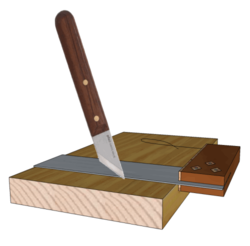Marking Knife: Difference between revisions
From DT Online
m (Corrected Links) |
m (Added link) |
||
| Line 1: | Line 1: | ||
[[File:UsingMarkingKnife.png|250px|right]] | [[File:UsingMarkingKnife.png|250px|right]] | ||
[https://en.wikipedia.org/wiki/Marking_knife '''Marking Knives'''] are used by woodworkers to strike a line across the | [https://en.wikipedia.org/wiki/Marking_knife '''Marking Knives'''] are used by woodworkers to strike a line across the [https://en.wikipedia.org/wiki/Wood_grain '''Grain'''] when marking out a '''[[Housing Joint]]''', '''[[Corner Lap Joint|Lap Joint]]''' or the shoulders of a '''[[Mortise and Tenon Joint|Tenon]]''' for example. This severs the wood fibres and makes for a cleaner edge when the joint is completed. | ||
Revision as of 09:01, 8 February 2016
Marking Knives are used by woodworkers to strike a line across the Grain when marking out a Housing Joint, Lap Joint or the shoulders of a Tenon for example. This severs the wood fibres and makes for a cleaner edge when the joint is completed.
Marking Knives are sharpened with a bevel on one side only of the blade which enables it to cut a line close to the edge of a Try Square blade, for example, and square to the timber surface. A Craft Knife can be used but will need to be tilted at a angle to cut the fibres square but has the advantage of being suitable for both left and right-handed use.
